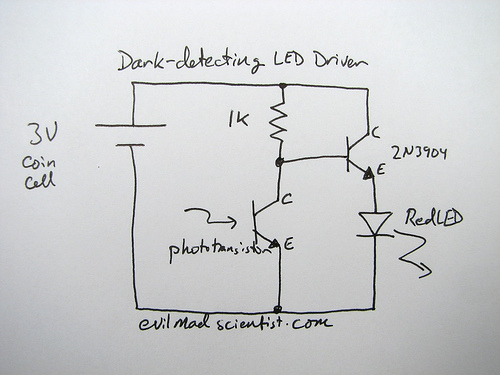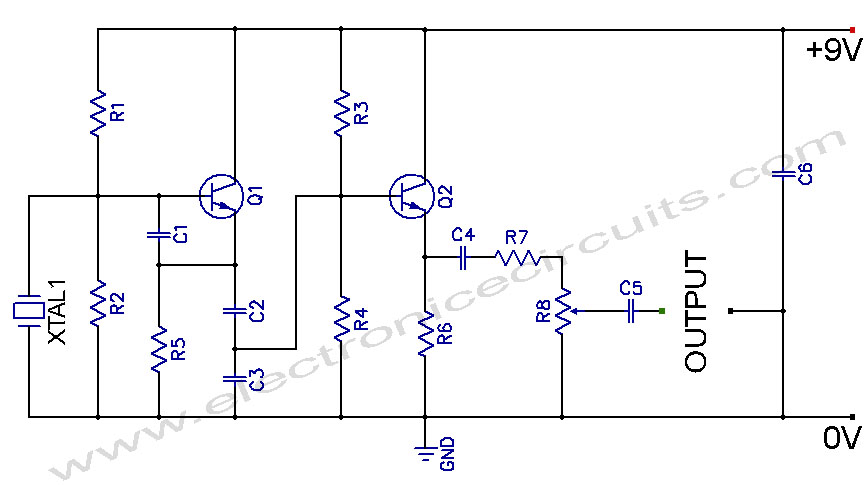
simple and cheap dark detecting led

How can an LED be activated in low light conditions? This scenario, often referred to as the "nightlight problem," is applicable in various situations such as emergency lights, street lights, and even computer keyboard backlights. There are numerous solutions available. A traditional approach involves using a CdS photoresistor, also known as a photocell or light-dependent resistor (LDR). While these photoresistors are reliable and cost approximately $1 each, they are becoming less common due to the presence of cadmium, a regulated toxic heavy metal. Alternative solutions exist, including op-amp based photodetector circuits with LED outputs and innovative designs found in solar garden lights, which sometimes utilize the solar cell as a sensor. This article demonstrates how to construct a very simple darkness-activated LED circuit using just three additional components, costing less than thirty cents collectively (even less when purchased in bulk). The assembly can be completed in under five minutes, especially with practice. Such an economical light-controlled LED circuit can be employed in various applications, including creating LED throwies that automatically turn off during the day to conserve power, potentially extending their lifespan to up to two weeks. The components used in this project include a CR2032 lithium coin cell (3V), an LED, an LTR-4206E phototransistor, a 2N3904 transistor, and a 1k resistor. The chosen LED is a bright red 10mm package with a luminosity of 60 candela, capable of casting a visible beam up to twenty feet in a well-lit environment. The sourcing of LEDs and batteries can be done through platforms like eBay, while other components are available from suppliers such as Digi-Key and Mouser. The LTR-4206E phototransistor, housed in a 3mm black package, is designed to block visible light, making it responsive only to infrared light. This feature ensures that the circuit activates in the dark.
The circuit begins with a basic LED configuration, similar to that of an LED throwie, where the LED is directly powered by a 3V lithium coin cell. The phototransistor is then integrated to detect light levels, controlling the transistor that activates the LED. Under light conditions, the phototransistor conducts up to approximately 1.5 mA, reducing the voltage across the resistor by 1.5 V, which deactivates the transistor and subsequently the LED. In darkness, the transistor allows approximately 15 mA to flow through the LED, resulting in a significant reduction in current consumption when the LED is off. It is important to note that the circuit utilizes a red LED due to the voltage drop across the transistor, which limits the voltage available to the LED to less than the full 3V. This voltage is marginal for powering blue LEDs; however, alternative methods such as using a low-cost FET may provide a solution for different LED types.
Assembly of the circuit can be performed on a breadboard, although creating a compact and deployable version is often more rewarding. The first step involves preparing the transistor and resistor. The 2N3904 transistor's pins are designated as Emitter, Base, and Collector when viewed from the front with the text readable. The resistor should be soldered between the Base and Collector leads of the transistor, ensuring proper orientation during assembly.How do you make an LED turn on when it gets dark. You might call it the "nightlight problem, " but the same sort of question comes up in a lot of familiar situations- emergency lights, street lights, silly computer keyboard backlights, and the list goes on. Solutions Lots. The time-honored tradition is to use a circuit with a CdS photoresistor, sometimes called a photocell or LDR, for "light-dependent resistor. " (Circuit Example 1, Example 2. ) Photoresistors are reliable and cost about $1 each, but are going away because they contain cadmium, a toxic heavy metal whose use is increasingly regulated. There are many other solutions as well. Look here for some op-amp based photodetector circuits with LED output, and check out some of the tricks used in well-designed solar garden lights, which include gems like using the solar cell itself as the sensor.
(Our own solar circuit collection is here. ) In this article we show how to build a very simple- perhaps even the simplest- darkness-activated LED circuit. To our LED and battery we add just three components, which cost less than thirty cents altogether (and much less if you buy in bulk).
You can build it in less than five minutes or less (much less with practice). What can you do with such an inexpensive light-controlled LED circuit Almost anything really. But, one fun application is to make LED throwies that turn themselves off in the daytime to save power. Throwies normally can last up to two weeks. Adding a light-level switch like this can significantly extend their lifetime. Here are our components: On top: a CR2032 lithium coin cell (3 V). On the bottom (L-R): the LED, an LTR-4206E phototransistor, a 2N3904 transistor, and a 1 k resistor. This LED is red, blindingly bright at 60 candela, in a 10 mm package. It casts a visible beam, visible for about twenty feet in a well-lit room. We got the LEDs and batteries on eBay, and the other parts are from Digi-Key, but Mouser has them as well.
As we mentioned, the last three cost about $0. 30 all together, and much less in bulk. The LTR-4206E is a phototransistor in a 3mm black package. The black package blocks visible light, so it is only sensitive to infrared light- it sees sunlight and incandescent lights, but not fluorescent or (most) discharge lamps- it really will come on at night. Our starting point is the simplest LED circuit: that of the LED throwie, which has an LED driven directly from a 3V lithium coin cell.
(Funny looking example here. ) From this, we add on the phototransistor, which senses the presence of light, and we use its output to control the transistor, which turns the LED on. When light falls on the phototransistor, it begins to conduct up to about 1. 5 mA, which pulls down the voltage at the lower side of the resistor by 1. 5 V, turning off the transistor, which turns off the LED. When it`s dark, the transistor is able to conduct about 15 mA through the LED. So, the circuit uses only about 1/10 as much current while the LED is off. One thing to note about this circuit: We`re using a red LED. That`s because the voltage drop across the transistor allows less than the full 3 V across the LED. The full three volts is really only marginal for driving blue LEDs anyway, so two-point-something really doesn`t cut it.
(Might be able to work around that with a cheap FET- haven`t tried yet. ) And now, let`s build it. You can certainly put this together on a breadboard, but there`s something more satisfying about the compact and deployable build that we walk through here. First get the transistor and the resistor. The pins of the 2N3904 are called (left-to-right) Emitter, Base, Collector, when viewing it from the front such that you can read the writing.
We`re going to solder the resistor between the leads of the Base and Collector of the transistor. Unusual part: hold the resistor with its leads at 90 degrees to those of the transi 🔗 External reference
The circuit begins with a basic LED configuration, similar to that of an LED throwie, where the LED is directly powered by a 3V lithium coin cell. The phototransistor is then integrated to detect light levels, controlling the transistor that activates the LED. Under light conditions, the phototransistor conducts up to approximately 1.5 mA, reducing the voltage across the resistor by 1.5 V, which deactivates the transistor and subsequently the LED. In darkness, the transistor allows approximately 15 mA to flow through the LED, resulting in a significant reduction in current consumption when the LED is off. It is important to note that the circuit utilizes a red LED due to the voltage drop across the transistor, which limits the voltage available to the LED to less than the full 3V. This voltage is marginal for powering blue LEDs; however, alternative methods such as using a low-cost FET may provide a solution for different LED types.
Assembly of the circuit can be performed on a breadboard, although creating a compact and deployable version is often more rewarding. The first step involves preparing the transistor and resistor. The 2N3904 transistor's pins are designated as Emitter, Base, and Collector when viewed from the front with the text readable. The resistor should be soldered between the Base and Collector leads of the transistor, ensuring proper orientation during assembly.How do you make an LED turn on when it gets dark. You might call it the "nightlight problem, " but the same sort of question comes up in a lot of familiar situations- emergency lights, street lights, silly computer keyboard backlights, and the list goes on. Solutions Lots. The time-honored tradition is to use a circuit with a CdS photoresistor, sometimes called a photocell or LDR, for "light-dependent resistor. " (Circuit Example 1, Example 2. ) Photoresistors are reliable and cost about $1 each, but are going away because they contain cadmium, a toxic heavy metal whose use is increasingly regulated. There are many other solutions as well. Look here for some op-amp based photodetector circuits with LED output, and check out some of the tricks used in well-designed solar garden lights, which include gems like using the solar cell itself as the sensor.
(Our own solar circuit collection is here. ) In this article we show how to build a very simple- perhaps even the simplest- darkness-activated LED circuit. To our LED and battery we add just three components, which cost less than thirty cents altogether (and much less if you buy in bulk).
You can build it in less than five minutes or less (much less with practice). What can you do with such an inexpensive light-controlled LED circuit Almost anything really. But, one fun application is to make LED throwies that turn themselves off in the daytime to save power. Throwies normally can last up to two weeks. Adding a light-level switch like this can significantly extend their lifetime. Here are our components: On top: a CR2032 lithium coin cell (3 V). On the bottom (L-R): the LED, an LTR-4206E phototransistor, a 2N3904 transistor, and a 1 k resistor. This LED is red, blindingly bright at 60 candela, in a 10 mm package. It casts a visible beam, visible for about twenty feet in a well-lit room. We got the LEDs and batteries on eBay, and the other parts are from Digi-Key, but Mouser has them as well.
As we mentioned, the last three cost about $0. 30 all together, and much less in bulk. The LTR-4206E is a phototransistor in a 3mm black package. The black package blocks visible light, so it is only sensitive to infrared light- it sees sunlight and incandescent lights, but not fluorescent or (most) discharge lamps- it really will come on at night. Our starting point is the simplest LED circuit: that of the LED throwie, which has an LED driven directly from a 3V lithium coin cell.
(Funny looking example here. ) From this, we add on the phototransistor, which senses the presence of light, and we use its output to control the transistor, which turns the LED on. When light falls on the phototransistor, it begins to conduct up to about 1. 5 mA, which pulls down the voltage at the lower side of the resistor by 1. 5 V, turning off the transistor, which turns off the LED. When it`s dark, the transistor is able to conduct about 15 mA through the LED. So, the circuit uses only about 1/10 as much current while the LED is off. One thing to note about this circuit: We`re using a red LED. That`s because the voltage drop across the transistor allows less than the full 3 V across the LED. The full three volts is really only marginal for driving blue LEDs anyway, so two-point-something really doesn`t cut it.
(Might be able to work around that with a cheap FET- haven`t tried yet. ) And now, let`s build it. You can certainly put this together on a breadboard, but there`s something more satisfying about the compact and deployable build that we walk through here. First get the transistor and the resistor. The pins of the 2N3904 are called (left-to-right) Emitter, Base, Collector, when viewing it from the front such that you can read the writing.
We`re going to solder the resistor between the leads of the Base and Collector of the transistor. Unusual part: hold the resistor with its leads at 90 degrees to those of the transi 🔗 External reference





